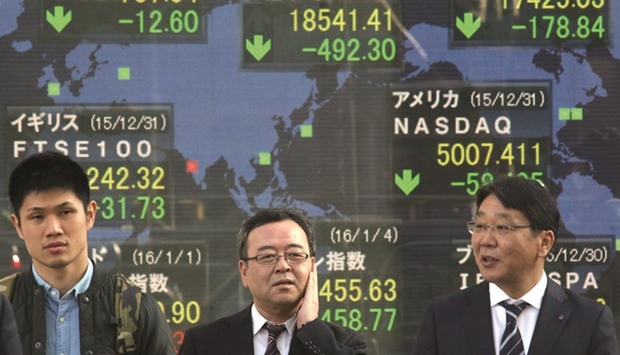Chinese stocks plunged yesterday, leading an Asian meltdown on the first day of 2016 trading, as more weak factory data fanned fears about a slowdown in the world’s number two economy.
The plunge in mainland markets further spooked investors already nervous about a flare-up in tensions between Iran and Saudi Arabia.
In Tokyo, the Nikkei 225 down 3.1% at 18,450.98 points; Hong Kong’s Hang Seng fell 2.7% at 21,327.12 points; Shanghai composite down 6.9% at 3,296.26 points and Shenzhen composite down 8.2% at 2,119.16 points at the close yesterday.
Authorities in China suspended trading on its stock markets in the early afternoon after shares sank 7%.
The drop in the CSI300 index—which covers the Shanghai and Shenzhen bourses—for the first time triggered an automatic early closure under a new system to curb volatility, after an earlier 15-minute trading halt failed to stem the declines.
The sharp losses revived memories of the summer rout that saw Shanghai crash about 40% and trillions of dollars wiped off valuations. Dealers began selling immediately after data from official and private surveys of manufacturing showed activity shrinking in December. The reports are the latest to highlight weakness in the economy, which is expected to have grown in 2015 at its slowest pace in a quarter of a century.
Adding to the selling is the looming expiration of measures brought in to curb last year’s share slump.
China yesterday also cut the yuan’s value against the greenback, making it weaker than 6.5 for the first time in more than four-and-a-half years, as pressure on the currency mounts from the country’s growth slowdown. “The weaker PMI and the weaker yuan are the likely triggers,” said Michael Every, head of financial markets research at Rabobank Group in Hong Kong.
The Shanghai market ended 6.9% lower while Shenzhen shed 8.2%.
Markets across Asia were stung by the losses, as well as news that Saudi Arabia had severed diplomatic ties with its old foe Iran Sunday after protesters ransacked its embassy in Tehran following the execution of a Shiite cleric.
Riyadh gave Iranian diplomats two days to leave the kingdom, while the supreme leader in Tehran said Saudi Arabia would face “quick consequences” for the execution.
The developments are the latest to inflame the region and join a list of negative news that hurt world markets over the past year, including China’s economic malaise, plunging oil prices and anaemic global growth.
“It’s going to be a testy start to the week,” said Angus Nicholson, a Melbourne-based market strategist at IG. US benchmark West Texas Intermediate climbed 1.7% and Brent surged 1.9%.
Investors fled to safe investments such as the US dollar and yen, sending stocks and emerging-market currencies falling.
Tokyo’s Nikkei index tumbled more than 3% as a strong yen hit exporters, while Hong Kong was off 2.7% and Seoul ended 2.2% down. On forex markets the dollar surged 1.2% against its Australian counterpart, while it was up 1.3% against the South Korean won and 0.9% against the Malaysian ringgit.
It also saw sharp gains against the Taiwan and New Zealand dollars as well as Indonesia’s rupiah and the Thai baht.
However, the greenback fell below ¥119 to a four-month low, with the Japanese unit considered a safe haven investment in times of turmoil.

Pedestrians walk past a share prices board in Tokyo. The Nikkei 225 closed down 3.1% at 18,450.98 points yesterday.


